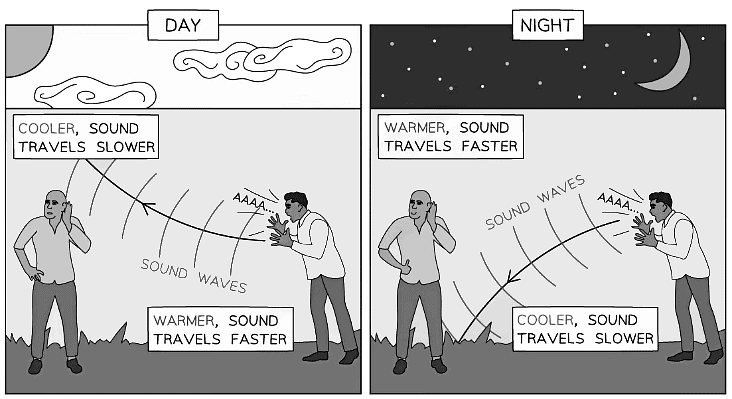Grade 10 Exam > Grade 10 Notes > Physics for Grade 10 > Transmission of Sound Waves
Transmission of Sound Waves | Physics for Grade 10 PDF Download
Sound Waves Transmission
- Sound waves are longitudinal waves
- They transfer energy by the molecules vibrating and knocking into neighbouring molecules
- The more molecules that are present the faster the wave can transfer energy, therefore:
- Sound waves travel fastest in solids
- Sound waves travel slowest in gases
- When sound waves move from one medium to another, there will be changes to its:
- Wave speed
- Frequency
- Wavelength
- The relationship between the wave speed, wavelength and frequency can be determined using the wave equation
- This change in velocity can also result in a change of direction of the sound wave
- This phenomenon is also known as refraction
Refraction of Sound
- When sound moves from a denser medium to a less dense medium:
- The wavelength of the sound wave increases
- The frequency of the sound wave stays the same
- The velocity of the sound wave increases
- When sound moves from a less dense medium to a denser medium:
- The wavelength of the sound wave decreases
- The frequency of the sound wave stays the same
- The velocity of the sound wave decreases
Solved Example
A man shouts across an empty field to a friend during the day, and then again during the night. He finds his friend can hear him more clearly at night because the sound travels further at night.Explain why sound travels further at night than during the day.
Step 1: Identify the difference in conditions between the day and the night
- During the day, it is warmer near the ground and cooler in the atmosphere
- At night, it is cooler near the ground and warmer in the atmosphere
Step 2: Consider the effect of sound waves travelling between the two air temperatures
- Sound waves can travel faster in hot air and slower in cold air
- This change in temperature will cause the sound waves to refract
Step 3: Explain the motion of the waves during the day and the night
- During the day, the sound wave will travel faster in the warm air and refract towards the sky as the wave slows down
- At night, the sound wave will travel slower in the cool air and refract towards the ground as the wave speeds up
Step 4: Relate the explanation back to the question
- Sound travels further at night because its speed increases as it moves from a denser medium (cold air) to a less dense medium (warm air)

The document Transmission of Sound Waves | Physics for Grade 10 is a part of the Grade 10 Course Physics for Grade 10.
All you need of Grade 10 at this link: Grade 10
|
122 videos|150 docs|40 tests
|
Related Searches
















